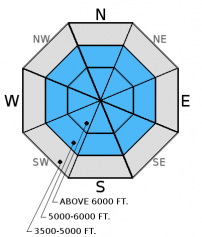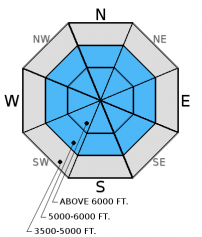| Saturday | Saturday Night | Sunday | |
|---|---|---|---|
| Cloud Cover: | Light snow showers and decrease in wind. | Lingering snow showers. | Cooler temperature, increasing snow showers and wind. |
| Temperatures: | 25-35 deg. F. | 14-22 deg. F. | 23-31 deg. F. |
| Wind Direction: | SW | SW | S-SW |
| Wind Speed: | 6-8 | 5-8 | 7-10 gusts 21 |
| Snowfall: | 1 in. | 1 in. | 1-2 in. |
| Snow Line: |
Whitefish Range
Swan Range
Flathead Range and Glacier National Park
How to read the forecast
Today, the avalanche danger is CONSIDERABLE above 5500 feet*. Human triggered avalanches are likely in new storm and wind slabs formed on lower density snow from earlier this week. Below 5500 feet* the danger is MODERATE. Continue to evaluate how recent snow and wind drifted snow affects deeper instabilities such as weak snow beneath the Dec. 9 crust.

3. Considerable
?
Above 6500 ft.
3. Considerable
?
5000-6500 ft.
2. Moderate
?
3500-5000 ft.
- 1. Low
- 2. Moderate
- 3. Considerable
- 4. High
- 5. Extreme
-
Type ?
-
Aspect/Elevation ?

-
Likelihood ?CertainVery LikelyLikelyPossible
 Unlikely
Unlikely -
Size ?HistoricVery LargeLargeSmall

New snow with warming temperatures and moderate to strong winds created storm slabs and wind slabs over the past 24 hours. These slabs were formed atop lighter snow from earlier in the week that will struggle to support the load. In areas that received the upper end of the snow load and in wind loaded areas pay attention to the affect the added weight has on deeper instabilities like near the Dec. 9 rain crust. Yesterday, we found sensitive storm and wind slabs up to 16 inches thick. Watch for convex pillows of wind drifted snow and a hollow feeling surface snow.
-
Type ?
-
Aspect/Elevation ?

-
Likelihood ?CertainVery LikelyLikelyPossible
 Unlikely
Unlikely -
Size ?HistoricVery LargeLargeSmall

In most of our recent observations we found weak and weakening snow beneath the December 9th rain crust. There is variability in stability test results in this layer, but it is important to continue to evaluate it particularly with the recent load. Also, in some locations in the Flathead Range, Glacier Park, and parts of the Swan Range we noted weak, sugary snow near the ground. In some places it breaks and propagates across a column in stability tests (video), and sometimes it doesn't even break. These faceted grains are generally found in areas of thin snowpack and around rocks. With the December 9 rain crust fairly thick in places, it makes affecting these deeper layers more difficult, but still possible.
With this variability, you'll need to carefully evaluate each slope before committing to it. This could be the storm that is just enough to tip the balance and awaken these deeper layers. Pay attention to obvious signs of instability like cracking, collapsing, "whumpfing", and, of course, recent avalanche activity. If you observe these signs, it's wise to stick to low angled slopes and away from avalanche terrain.
*The upper end (above 5500 feet) of the mid-elevation band is rated CONSIDERABLE and below this the danger is rated MODERATE.
Yesterday, Erich and I rode into the Lost Johnny drainage and skied up Hash Mountain where we observed obvious signs of storm and wind slab instability including: cracking, collapsing, and we triggered a couple of soft slab avalanches (photo) from the ridgeline above (Observation, Video).
Skiers on lower Elk Mountain in the Flathead Range found a shallow snowpack (70cm) and unconsolidated recent snow on top of the rain crust. With the warming that occured yesterday they noted an "upside down" storm layer forming in the 8-10 inches of new snow. They did not observe any obvious signs of instability, but they also found depth hoar present in this location.
Thursday, before the storm, Erich and I skied into the backcountry east of the boundary of Whitefish Mountain Resort to the Chicken Bones area. We found a relatively strong snowpack with no facets near the ground, but weak snow below the December 9 rain crust made us think about how the incoming storm will interact with it (video, observation).
Skiers on Elk Mt. (observation) and another party on False Shields (Peak 7798) in southern Glacier Park yesterday found mostly unconsolidated surface snow (read: powder) with thin wind slab development just near ridgetops. Stability tests showed mixed results with deeper instabilities.
Other skiers in Canyon Creek in the southern Whitefish Range observed loose sluffing on steep slopes with some wind slab formation.
Visit our Observations page and our You Tube channel for more information from the entire season.
Please let us know what you are seeing out there. Your observations are important and valued.
HOW TO SUBMIT OBSERVATIONS:
Email: [email protected]
Call and leave a message: 406.387.3821
You can also submit quick observations via text: 406.241.4571 (FAC mobile)
OR
Submit Snowpack Observations: http://www.flatheadavalanche.org/node/add/snowobs
Submit Avalanche Observations: http://www.flatheadavalanche.org/node/add/avyobs
In the past 24 hours 2-5 inches of snow fell across the advisory area with more impressive snow water equivalents that range from 0.25-1.00 inch (Flattop Mountain SNOTEL). Temperatures warmed to the upper 20s to low 30s and winds were out of the southwest at 5-10 mph with gusts in the 40s mph. Currently, mountain temperatures range from 21º-27º F and winds are out of the southwest at 1-9 mph with gusts from 10-15 mph. Today, expect light snow showers with winds blowing 5-10 mph out of southwest, temperatures should remain in upper 20s F.
| 0600 temperature: | 20-27 deg. F. |
| Max. temperature in the last 24 hours: | 24-30 deg. F. |
| Average wind direction during the last 24 hours: | SW |
| Average wind speed during the last 24 hours: | 5-15 mph |
| Maximum wind gust in the last 24 hours: | 15-25 mph |
| New snowfall in the last 24 hours: | 2-5 inches |
| Total snow depth: | 42-55 inches |
This advisory applies only to backcountry areas outside established ski area boundaries. This advisory describes general avalanche conditions and local variations always occur. This advisory expires at midnight on the posted day unless otherwise noted. The information in this advisory is provided by the USDA Forest Service who is solely responsible for its content.




























